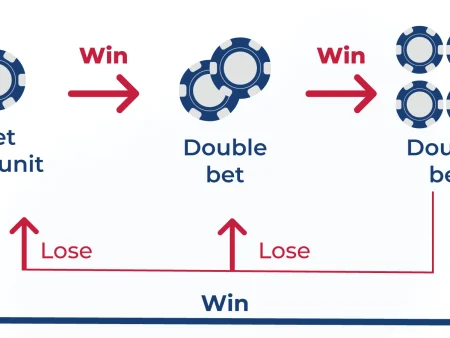
The Origins and Principle
The Martingale betting system is one of the most ancient forms of betting, rooted in the 18th Century and introduced by the renowned French mathematician Paul Pierre Levy. The core principle of this system is doubling down on bets with the belief that continuous investment will eventually lead to a win, compensating for previous losses. Levy’s statistical concept emphasizes that perpetual loss is highly unlikely, hence the strategy’s appeal.
Functioning of the Martingale System
In the Martingale system, the guiding assumption is that persistence in betting will eventually yield a profit surpassing cumulative losses. This system has gained immense popularity among casino enthusiasts, particularly in games like roulette. Players are convinced that after a sequence of losses, a win is inevitable, allowing them to double their bets to recover past losses. However, this strategy requires a substantial bankroll to withstand numerous losses. The classical Martingale approach involves doubling the bet after each loss until a win is achieved or funds are depleted. For instance, doubling an initial bet of 100 units will align with the Martingale strategy if the objective is to secure a 1:1 payoff.
For games offering an 8:1 payoff, there is no necessity to increase the bet until after the eighth loss. The continual doubling of bets can result in very large stakes, often restricted by table limits.
Understanding the Mechanics
To comprehend the mechanics of the Martingale system, consider a simple example of a coin toss. Each flip (heads or tails) is independent of previous outcomes, meaning the result of the second toss is not influenced by the first. The strategy is straightforward: after each loss, increase your bet size so that a win will not only recover previous losses but also return to the initial bet amount.
Application in Casino Games
The Martingale system is most effective in casino games like roulette, particularly on bets with roughly a 50% winning chance such as red or black, and even or odd. These bet types offer the lowest payout, but the potential to get back the same amount of money used in the spin makes them popular choices.
For instance, an even bet sequence might look like this: (2-4-8-16-32-64-128-256-512……), where each number doubles the previous bet and is always divisible by two.
Placing Bets and the Doubling Up Concept
Begin with the minimum table bet and continue with it until a loss occurs. Upon losing, double the bet for the next round. If you win, not only do you make a profit, but you also recover prior losses. Following a win, revert to the initial bet amount and repeat the process. This cycle continues until another win is achieved, ensuring the strategy resets.
Practical Considerations and Limitations
While theoretically, the Martingale system allows for indefinite doubling of bets to achieve a small profit after each win, practical limitations exist. In reality, numerous factors hinder this approach. Continuous wins over an extended period are unlikely, and the eventual impact on your bankroll could be substantial. The system’s reliance on an infinite bankroll and absence of table limits does not align with real-world constraints, highlighting its limitations.
Can the Martingale System Beat the House?
The house edge is notoriously difficult to overcome, primarily because the odds are stacked against players. Despite the apparent simplicity and allure of the Martingale system, it cannot consistently defeat the house edge. Casinos and bookmakers have designed their games to ensure they maintain an advantage. A key factor contributing to this is the green zero on the roulette wheel, which does not fall into any betting category, representing a pure house advantage.
Hidden Dangers of Using the Martingale
Many of the risks associated with the Martingale system are not immediately obvious. The core concept of doubling bets after each loss inherently involves significant risk. The more you bet, the more you deplete your bankroll. One of the hidden dangers is that once your bankroll is exhausted, you cannot continue to double up on losses. Additionally, each roulette table has preset limits, and during a prolonged losing streak, you are likely to hit these limits. When this happens, you are unable to double your bet further, making it impossible to recover lost money.
Can the Martingale System Help You Win?
While the Martingale system may offer small winnings in the short term, it is not considered an effective long-term strategy due to its high risk. Over time, as you continue doubling bets after losses, the system can lead to significant cumulative losses that surpass any short-term gains. The mathematical reality is that if you lose more often than you win, the system will not be profitable.
Punters often favor this strategy initially because it seems to yield results. However, over extended play, many realize they are losing more than they win. Without preparing for potential substantial losses, it is advisable to avoid this strategy, as the house always wins in the end.
Why Does the System Not Work in the Long Run?
There are two primary reasons the Martingale system fails over extended periods:
Roulette Odds
Roulette bets are typically placed on red or black. Many players believe that if red has won several times in a row, black is due to win next. However, each spin of the roulette wheel is independent, and the Martingale system does not influence the odds. Success remains largely dependent on luck.
Table Limits
Roulette tables have betting limits that prevent players from indefinitely doubling their bets. These limits hinder the ability to recoup losses, ultimately leading to financial losses that the system cannot overcome.
Pros of the Martingale System
- Legality: The system is legal, so players can use it without concern for breaking casino rules.
- Beginner-Friendly: It is easy to understand and offers the potential for quick profits.
- Simplicity: The Martingale system is more straightforward compared to other methods, such as the Labouchere system.
Cons of the Martingale System
- High Bankroll Requirement: Significant funds are needed to sustain the doubling process during losing streaks.
- Long-Term Profitability Issues: Over time, the profitability diminishes, especially after numerous losses.
- Restrictive Table Limits: During winning streaks, table limits become more restrictive, preventing further doubling and potential recovery of losses.
In conclusion, while the Martingale system can offer short-term excitement and potential gains, its inherent risks and limitations make it a less viable strategy for long-term betting success. Players should be cautious and consider these factors before relying on the Martingale system in their gambling endeavors.







